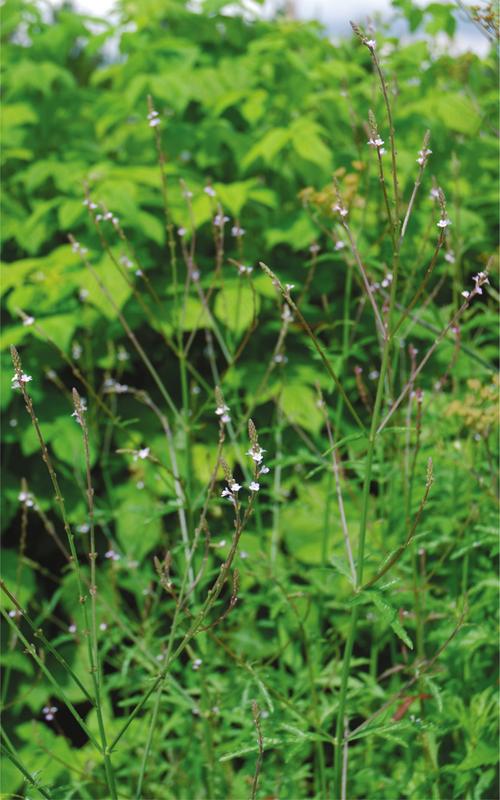A herb with a reputation for magic as well as medicine, vervain has a long history of use in Europe and Asia. It had so many reputed benefits that it gained a name as a cure-all; it was sacred for the Druids and used as an altar plant in ancient Rome.
It restores and calms the nervous system, is a digestive tonic and alleviates headaches. It can be used for premenstrual tension, menopausal hot flushes, fevers, gallstones, jaundice, asthma, insomnia, anxiety, stress and tension. Vervain is a go-to restorative during convalescence from chronic or long-term illness.
Verbenaceae Verbena family
Description: A slender perennial, to 60cm, with square stalks and spikes of small white or pale lilac flowers in late summer.
Habitat: Road verges and grassy places, especially on lime.
Distribution: Found in the southern British Isles, across Europe and Asia to Japan.
Related species: There are no other wild members of the verbena family found in the British Isles. The North American blue vervain (V. hastata) is used similarly. Lemon verbena (Aloysia triphylla) is often called vervain.
Parts used: Above-ground parts when in flower.

Vervain is such a delicate plant that it is easy to overlook, but its medicinal power is belied by its humble appearance. Tincturing it is always surprising, as a few skinny stalks of pale lilac or white flowers yield a strong, dark, almost black, brew.
Vervain has a rich past, both magical and medicinal, sacred and secular. It was an important herb to the Druids and Romans. Picking was always accompanied, until recent times, by a prayer.
Once used to treat madness and epilepsy, vervain is a powerful nerve restorative, and is particularly good for nervous exhaustion following periods of prolonged physical activity or stress. It is excellent in convalescence for the weakness that follows viral infections. Julie has used it to treat ME/chronic fatigue syndrome.
Vervain is a good herb to have on hand for the stress and hurried pace of modern lifestyles. It is particularly suited to people who are strong-willed, enthusiastic, work too hard and cannot relax. It is one of Edward Bach’s 38 original flower remedies, a specific for this type of intensity.
The physicians of Myddfai, in Wales in the thirteenth century, recommended vervain for scrofula, a tubercular infection of the lymph glands in the neck. Later, the great English herbalists had an uneasy relationship with the plant, Gerard decrying it and Culpeper favouring it. Parkinson (1640) chose the positive side by recommending vervain for ‘generally all the inward paines and torments of the body’.
Use vervain for…
Because vervain works on the nervous system, liver, kidneys and digestion and also balances hormones, in addition to being a wound herb, it is still valid in an unusual array of conditions, and deserves to be more widely used.
A vulnerary treatment in classical Rome, the crushed or chewed fresh leaf can still be applied to cuts and scrapes to soothe and promote healing. It is effective where there is heat and irritation, so works well on bramble scratches, boils and burns.
Vervain had a role in both love and war in Rome. It was aphrodisiac, being dedicated to Venus: a Roman bride would wear a sprig at her wedding. A verbenarius was a herald-at-arms who wore a chaplet of vervain as a flag of truce.
Coming to recent times, research in the United States confirms that vervain, along with self-heal, is a top herb for normalising levels of thyroid hormones, being effective in both the underactive and overactive conditions. Vervain appears to affect the amount of TSH (thyroid-stimulating hormone) released by the pituitary gland.

Drinking vervain tea very hot will make you sweat, which means it is a really effective treatment at the start of a cold or fever, when you are actively eliminating toxins. But it also relaxes and soothes, settling an upset digestion as well as a preoccupied, racing mind.

As a tincture, vervain is cooling for menopausal hot flushes. It is particularly valuable to have available where restlessness and nervous tension are part of the menopausal picture.
Vervain tea is good for childhood illnesses, where the child is restless and irritable. Instead of fidgeting, he or she will be helped to relax and recuperate. If there is a fever, vervain will encourage sweating and prevent the temperature from going too high. It combines well with lime blossom or elderflower for fevers.
Although there has been too little modern research on vervain, experience and the clinical practice of the herbalists who use it largely support its old reputation as a ‘heal-all’. It is a safe remedy, gentle enough for children and convalescents, and tonic for older people.
Unfortunately, vervain seems to be becoming less common as a wild plant in Britain. If you can’t find any near you, it is worth growing some in your own garden for medicinal use.
Harvesting vervain
Pick vervain when in flower, ideally towards the end of flowering. For use as a tea, dry the above-ground parts whole in an airing cupboard or in the open air on a piece of paper. When the plant is crisp, discard the larger stems and cut up or crumble into small pieces.
Vervain tea
Use a heaped teasoonful of the dried herb per mug of boiling water, and allow to steep for 5 minutes. Strain and drink hot.
Dose: 1 mug three times a day. For insomnia from restlessness, drink a cupful or two in the evening. For sprains and deep bruises, 2 or 3 cups a day for at least three or four days.
Combinations: Mixes well with lime blossom for flavour and therapeutic value; also effective with self-heal.
Vervain tincture
Chop up fresh vervain and put in a blender with enough vodka to cover. Blend briefly, then pour the mixture into jars and keep in a cool dark place for a week. Strain and bottle.
Dose: 20 drops in a little water three times daily.